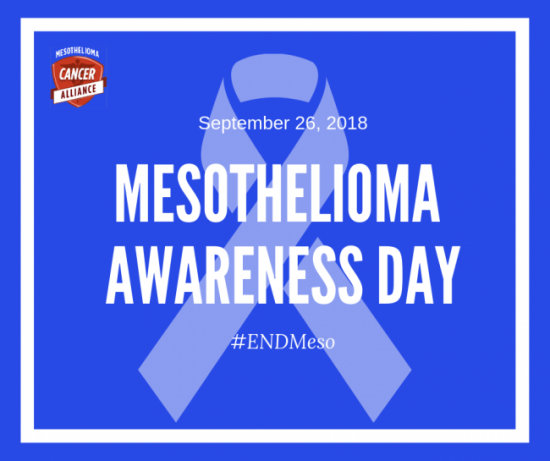Mesothelioma Awareness Day 2018
Cancer affects everyone whether it’s through a personal experience or a family member or loved one. There are more than 100 different types of cancer that affect people around the world on a daily basis. Each cancer is unique and may impact different populations at varying levels. The more rare cancers are just as devastating and may progress at a faster rate due to patients being uneducated. Mesothelioma cancer is among the subset of rare cancers.
Established in 2004 by the Mesothelioma Applied Research Foundation Mesothelioma Awareness Day, September 26, is the day we shed light about this rare disease and all those who’ve been affected by mesothelioma cancer.

What is Mesothelioma?
Mesothelioma is a rare cancer that develops in the lining of the lungs, abdomen, or cardiovascular cavity. According to a 2017 study conducted by the Center for Disease Control and Prevention, there are between 2,400 and 2,800 people each affected by mesothelioma year in the United States.
There are three known types of mesothelioma; pleural, peritoneal, and pericardial. Pleural mesothelioma is the most common form of the cancer, developing in the lining of the lungs. The cancerous tumors after exposure to asbestos. Peritoneal mesothelioma is caused by inhaled or ingested asbestos fibers that then become trapped in the lining of the abdomen. Thirdly, mesothelioma may occur when asbestos fibers get lodged in the pericardium, or the lining of the heart cavity.
What is Asbestos?
Asbestos is a group of six silicate minerals made up of microscopic fibers that were used as thermal insulation. Peak popularity dates back to the 1930s, but use was largely halted in the 1970s after the fibers were declared a “known human carcinogen.” The fibers become hazardous if the material is disrupted because asbestos is only dangerous after entering the body by way of inhalation or ingestion. The microscopic fibers cling to the lining of the body’s organs, get trapped, and can later develop into cancer.
The cancer has a long latency period, it is typical for symptoms to lay dormant for anywhere between 20 and 50 years. In the United States, it is still legal for one percent of asbestos to be used in manufacturing products for several industries.
Who is at Risk?
Throughout history mesothelioma has been known as the “old man’s cancer” since most patients are 55 and older. Today, professionals are aware of the dangerous carcinogenic properties asbestos has, unfortunately, the same could not be said 40 years ago. During the early 21st century many jobs left their employees, typically men, unknowingly in harm’s way. There are a number of professions that had a notable contact with asbestos.
Firefighters are among the most at risk of exposure to asbestos. These Americans risk their lives running into burning buildings, however after the fire has been fully extinguished danger remains. If the structures impacted by fire contain asbestos these fibers are often damaged during the fire fight and become airborne creating undue risk in the debris.
Construction is reportedly the most hazardous land-based job – among those hazards is asbestos exposure. More than one million construction workers are exposed to asbestos containing materials (ACMs) each year, 17 percent of injuries in the construction field are related to exposure to toxic material. Any level of contact with asbestos, minimal or not, creates the risk of developing asbestos-related illnesses later on, as there is no safe level of asbestos exposure.
Patients have contracted mesothelioma through both occupational and secondhand exposure. The secondhand exposure occurs when workers carry asbestos fibers home on their hair, skin, and clothing putting their families at risk. These fibers are not easily removed so women and children were often exposed through contact with their husbands or fathers.
Take Action
On September 26 a close knit community comes together to spread awareness about this especially harmful cancer. Mesothelioma Awareness Day honors those who have lost their battle, and to show support to those who continue their fight every day. Until there’s a cure established the best safeguard against further mesothelioma diagnoses is spreading knowledge of asbestos and the resulting mesothelioma cancer. Asbestos has been banned in more than 60 countries, but still legal in the United States. With asbestos still in legal use, the number of Americans at risk of developing an asbestos-related disease continues to grow. Any shift within the EPA’s regulations could potentially endanger more people than ever before. Know your risk of asbestos related disease and if you believe you’ve been exposed take the opportunity to discuss asbestos dangers with a medical professional.
[sexy_author_bio]

